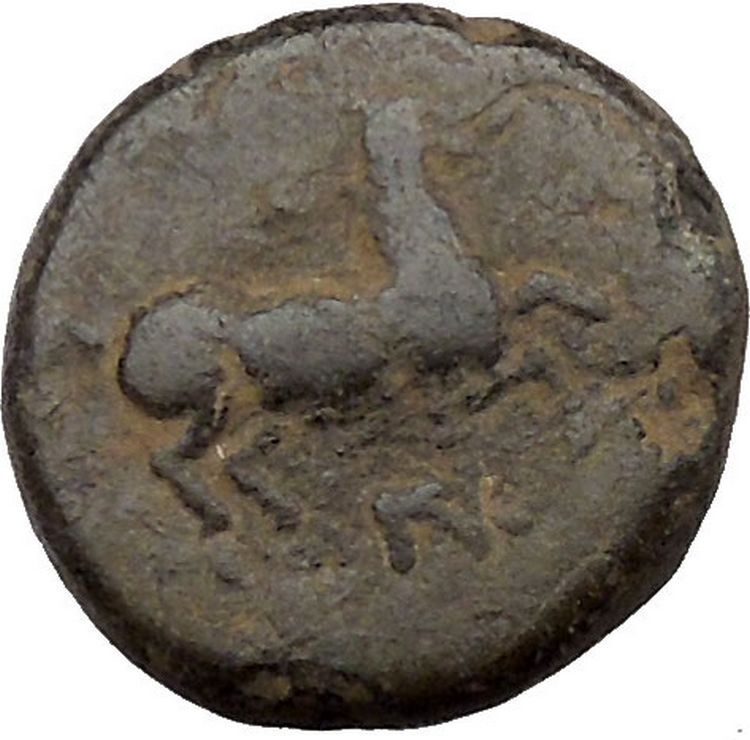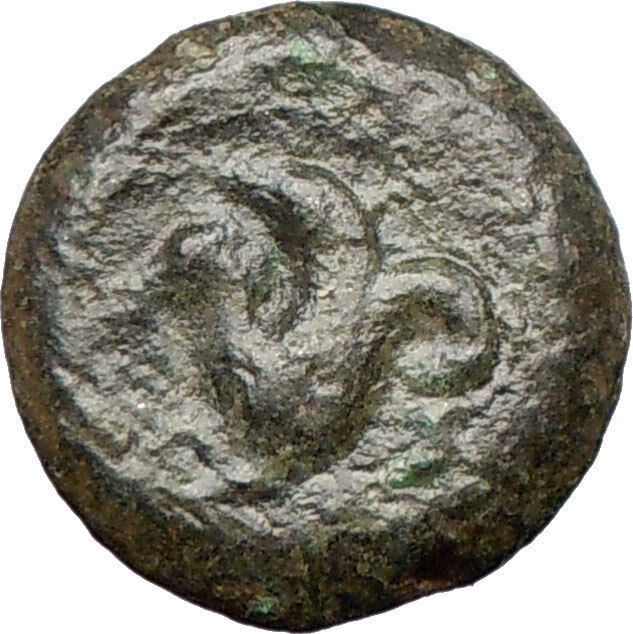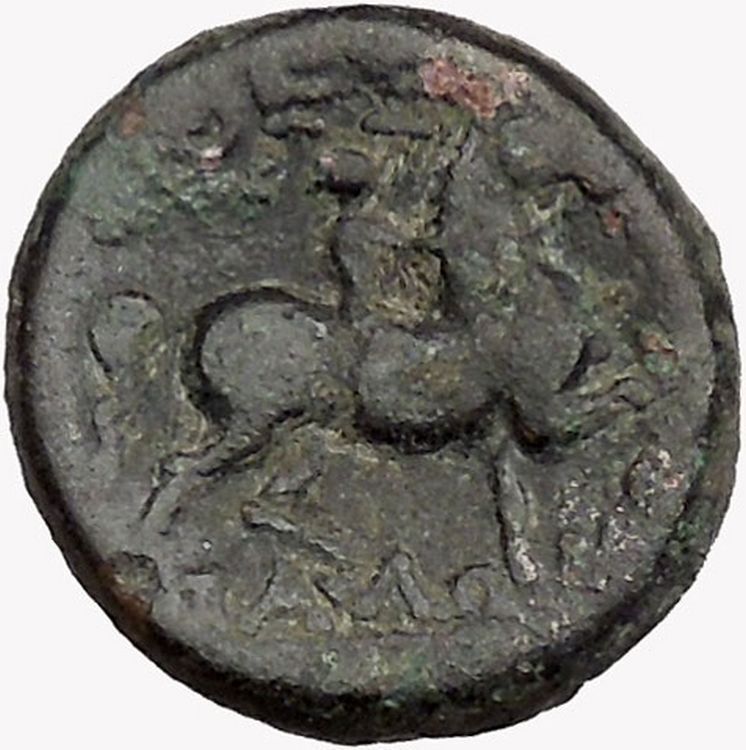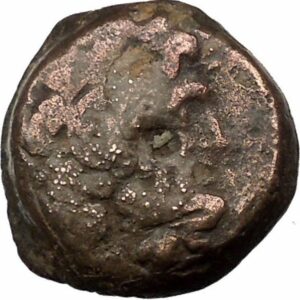|
Greek city of Amisos in Pontus
Bronze 20mm (7.92 grams) Struck under Mithradates VI the Great circa 85-65 B.C.
Reference: HGC 7, 242; Sear 3642; SNG Black Sea 1177-1191; B.M.C. 13. 20,74
Certification: NGC Ancients Ch VF 5771963-012
Aegis, with Gorgon’s head at center.
Nike advancing right, carrying palm-branch; ΑΜΙ – ΣΟΥ across field; monograms to left and to right.
In mythology, Amisos was believed to be the original settlement of the Amazons. It was originally founded by Greeks from the cities of Phokaia and/or Miletos in circa 560 B.C. It was a flourishing Greek city on the Black Sea coast commanding an important trade route to the south. Amisos was under the control of the Achaemenid Empire, then re-settled by Athenians in the following century and they renamed the place Peiraeus. In subsequent times it played important historical roles as a city of the Kingdom of Bosporus. It was given the status of a free city under the Romans.
You are bidding on the exact item pictured, provided with a Certificate of Authenticity and Lifetime Guarantee of Authenticity.
 In Greek mythology, Nike was a goddess who personified victory, also known as the Winged Goddess of Victory. The Roman equivalent was Victoria. Depending upon the time of various myths, she was described as the daughter of Pallas (Titan) and Styx (Water) and the sister of Kratos (Strength), Bia (Force), and Zelus (Zeal). Nike and her siblings were close companions of Zeus, the dominant deity of the Greek pantheon. According to classical (later) myth, Styx brought them to Zeus when the god was assembling allies for the Titan War against the older deities. Nike assumed the role of the divine charioteer, a role in which she often is portrayed in Classical Greek art. Nike flew around battlefields rewarding the victors with glory and fame. In Greek mythology, Nike was a goddess who personified victory, also known as the Winged Goddess of Victory. The Roman equivalent was Victoria. Depending upon the time of various myths, she was described as the daughter of Pallas (Titan) and Styx (Water) and the sister of Kratos (Strength), Bia (Force), and Zelus (Zeal). Nike and her siblings were close companions of Zeus, the dominant deity of the Greek pantheon. According to classical (later) myth, Styx brought them to Zeus when the god was assembling allies for the Titan War against the older deities. Nike assumed the role of the divine charioteer, a role in which she often is portrayed in Classical Greek art. Nike flew around battlefields rewarding the victors with glory and fame.
Nike is seen with wings in most statues and paintings. Most other winged deities in the Greek pantheon had shed their wings by Classical times. Nike is the goddess of strength, speed, and victory. Nike was a very close acquaintance of Athena, and is thought to have stood in Athena’s outstretched hand in the statue of Athena located in the Parthenon. Nike is one of the most commonly portrayed figures on Greek coins.
Names stemming from Nike include amongst others: Nicholas, Nicola, Nick, Nikolai, Nils, Klaas, Nicole, Ike, Niki, Nikita, Nika, Niketas, and Nico.
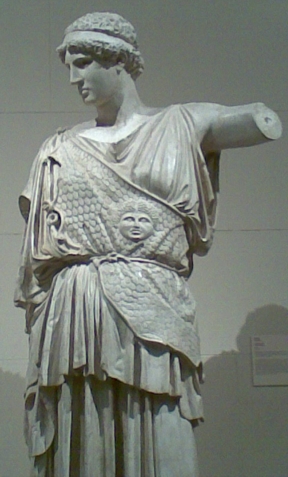 The aegis or aigis, as stated in the Iliad, is carried by Athena and Zeus, but its nature is uncertain. It had been interpreted as an animal skin or a shield, sometimes bearing the head of a Gorgon. There may be a connection with a deity named Aex or Aix, a daughter of Helios and a nurse of Zeus or alternatively a mistress of Zeus (Pseudo-Hyginus, Astronomica 2. 13). The aegis of Athena is referred to in several places in the Iliad. It produced a sound as from a myriad roaring dragons (Iliad, 4.17) and was borne by Athena in battle “… and among them went bright-eyed Athene, holding the precious aegis which is ageless and immortal: a hundred tassels of pure gold hang fluttering from it, tight-woven each of them, and each the worth of a hundred oxen.” The aegis or aigis, as stated in the Iliad, is carried by Athena and Zeus, but its nature is uncertain. It had been interpreted as an animal skin or a shield, sometimes bearing the head of a Gorgon. There may be a connection with a deity named Aex or Aix, a daughter of Helios and a nurse of Zeus or alternatively a mistress of Zeus (Pseudo-Hyginus, Astronomica 2. 13). The aegis of Athena is referred to in several places in the Iliad. It produced a sound as from a myriad roaring dragons (Iliad, 4.17) and was borne by Athena in battle “… and among them went bright-eyed Athene, holding the precious aegis which is ageless and immortal: a hundred tassels of pure gold hang fluttering from it, tight-woven each of them, and each the worth of a hundred oxen.”
Medusa, the gorgon, was beheaded by the hero Perseus, who thereafter used her head, which retained its ability to turn onlookers to stone, as a weapon until he gave it to the goddess Athena to place on her shield. In classical antiquity the image of the head of Medusa appeared in the evil-averting device known as the Gorgoneion. Gorgons were a popular image in Greek mythology, appearing in the earliest of written records of Ancient Greek religious beliefs such as those of Homer, which may date to as early as 1194-1184 BC. Because of their legendary and powerful gaze that could turn one to stone, images of the Gorgons were put upon objects and buildings for protection.
The modern concept of doing something “under someone’s aegis” means doing something under the protection of a powerful, knowledgeable, or benevolent source. The word aegis is identified with protection by a strong force with its roots in Greek mythology and adopted by the Romans; there are parallels in Norse mythology and in Egyptian mythology as well, where the Greek word aegis is applied by extension.

Depiction of Alexander the Great from an ancient Roman mosaic, wearing the gorgon head (Gorgoneion) as aegis on his breast plate while charging into battle.
 In Ancient Greece, the Gorgoneion was originally a horror-creating apotropaic pendant showing the Gorgon’s head. It was assimilated by the Olympian deities Zeus and Athena: both are said to have worn it as a protective pendant. It was assumed, among other godlike attributes, as a royal aegis, by rulers of the Hellenistic age, as shown, for instance, on the Alexander Mosaic and the Gonzaga Cameo. In Ancient Greece, the Gorgoneion was originally a horror-creating apotropaic pendant showing the Gorgon’s head. It was assimilated by the Olympian deities Zeus and Athena: both are said to have worn it as a protective pendant. It was assumed, among other godlike attributes, as a royal aegis, by rulers of the Hellenistic age, as shown, for instance, on the Alexander Mosaic and the Gonzaga Cameo.
Homer refers to the Gorgon on four occasions, each time alluding to the head alone, as if the creature had no body. Jane Ellen Harrison notes that “Medusa is a head and nothing more…a mask with a body later appended”. Up to the 5th century BC, the head was depicted as particularly ugly, with a protruding tongue, boar tusks, puffy cheeks, her eyeballs staring fixedly on the viewer and the snakes twisting all around her.
The direct frontal stare, “seemingly looking out from its own iconographical context and directly challenging the viewer”, was highly unusual in ancient Greek art. In some instances a beard (probably standing for streaks of blood) was appended to her chin, making her appear as an orgiastic deity akin to Dionysus.
Gorgoneia that decorate the shields of warriors on mid-5th century Greek vases are considerably less grotesque and menacing. By that time, the Gorgon had lost her tusks and the snakes were rather stylized. The Hellenistic marble known as the Medusa Rondanini illustrates the Gorgon’s eventual transformation into a beautiful woman.
 Samsun is a city in northern Turkey, on the coast of the Black Sea, with a population of over 1 million. It is the capital city of Samsun Province and an important port. Samsun was founded as the colony Amisos (alternative spelling Amisus, Eis Amison – meaning to amisos took the name Samsunta or Samsus (Eis Amison – Samson – Samsounta) as in Greek + ounta “Greek toponomical suffix”. ) by settlers from Miletus in the 7th century BC. Samsun is a city in northern Turkey, on the coast of the Black Sea, with a population of over 1 million. It is the capital city of Samsun Province and an important port. Samsun was founded as the colony Amisos (alternative spelling Amisus, Eis Amison – meaning to amisos took the name Samsunta or Samsus (Eis Amison – Samson – Samsounta) as in Greek + ounta “Greek toponomical suffix”. ) by settlers from Miletus in the 7th century BC.
History
Samsun’s original name was Enete (from Hitits.) Samsun’s ideal combination of fertile ground and shallow waters attracted numerous traders. Greek colonists settled in the 6th century BC and established a flourishing trade relationship with the ancient peoples of Anatolia. At that time, Samsun was part of the Greek colony of Amisus. In the 3rd century BC, Samsun came under the expanded rule of the Kingdom of Pontus. The Kingdom of Pontus had been part of the empire of Alexander the Great. However, the empire was fractured soon after Alexander’s death in the 4th century BC. At its height, the kingdom controlled the north of central Anatolia and mercantile towns on the northern Black Sea shores.
The Romans took over in 47 BC, and were replaced by the Byzantines after the fall of Rome. In 1200 Samsun was captured by the Seljuks, to be later taken over by the İlhanlılar. Samsun was incorporated into the network of Genoese trading posts and was taken by the Ottomans in the beginning of the 15th century. Before leaving, the Genoese razed the town.
Atatürk founded the Turkish republic movement at Samsun and it served as its base during the Turkish War of Independence.
For more details on this topic, see Turkish War of Independence.
The city is both an Eastern Orthodox and a Roman Catholic titular see.
Geography
Samsun is situated between two river deltas which jut into the Black Sea. It is located at the end of an ancient route from Cappadocia: the Amisos of antiquity lay on the headland northwest of the modern city. To Samsun’s west, lies the Kızılırmak (“Red River”, the Halys of antiquity), one of the longest rivers in Anatolia and its fertile delta. To the east, lie the Yeşilırmak (“Green River”, the Iris of antiquity) and its delta.
 Pontus is a historical Greek designation for a region on the southern coast of the Black Sea, located in modern-day eastern Black Sea Region of Turkey. The name was applied to the coastal region and its mountainous hinterland (rising to the Pontic Alps in the east) in antiquity by the Greeks who colonized the area and derived from the Greek name of the Black Sea: Pontos Euxeinos (“Hospitable Sea”), or simply Pontos. Having originally no specific name, the region east of the river Halys was spoken of as the country Ἐν Πόντῳ En Pontōi, “on the [Euxeinos] Pontos”, and hence it acquired the name of Pontus, which is first found in Xenophon’s Anabasis. The extent of the region varied through the ages but generally extended from the borders of Colchis (modern Georgia) until well into Paphlagonia in the west, with varying amounts of hinterland. Several states and provinces bearing the name of Pontus or variants thereof were established in the region in the Hellenistic, Roman and Byzantine periods, culminating in the late Byzantine Empire of Trebizond. Pontus is sometimes considered as the home of the Amazons, with the name Amazon used not only for a city (Amasya) but for all of Pontus in Greek mythology. Pontus is a historical Greek designation for a region on the southern coast of the Black Sea, located in modern-day eastern Black Sea Region of Turkey. The name was applied to the coastal region and its mountainous hinterland (rising to the Pontic Alps in the east) in antiquity by the Greeks who colonized the area and derived from the Greek name of the Black Sea: Pontos Euxeinos (“Hospitable Sea”), or simply Pontos. Having originally no specific name, the region east of the river Halys was spoken of as the country Ἐν Πόντῳ En Pontōi, “on the [Euxeinos] Pontos”, and hence it acquired the name of Pontus, which is first found in Xenophon’s Anabasis. The extent of the region varied through the ages but generally extended from the borders of Colchis (modern Georgia) until well into Paphlagonia in the west, with varying amounts of hinterland. Several states and provinces bearing the name of Pontus or variants thereof were established in the region in the Hellenistic, Roman and Byzantine periods, culminating in the late Byzantine Empire of Trebizond. Pontus is sometimes considered as the home of the Amazons, with the name Amazon used not only for a city (Amasya) but for all of Pontus in Greek mythology.
Pontus became important as a bastion of Byzantine Greek and Greek Orthodox civilization and attracted Greeks from all backgrounds (scholars, traders, mercenaries, refugees) from all over Anatolia and the southern Balkans, from the Classical and Hellenistic periods into the Byzantine and Ottoman. These Greeks of Pontus are generally referred to as Pontic Greeks.
|









 In Greek mythology, Nike was a goddess who personified victory, also known as the Winged Goddess of Victory. The Roman equivalent was Victoria. Depending upon the time of various myths, she was described as the daughter of Pallas (Titan) and Styx (Water) and the sister of Kratos (Strength), Bia (Force), and Zelus (Zeal). Nike and her siblings were close companions of Zeus, the dominant deity of the Greek pantheon. According to classical (later) myth, Styx brought them to Zeus when the god was assembling allies for the Titan War against the older deities. Nike assumed the role of the divine charioteer, a role in which she often is portrayed in Classical Greek art. Nike flew around battlefields rewarding the victors with glory and fame.
In Greek mythology, Nike was a goddess who personified victory, also known as the Winged Goddess of Victory. The Roman equivalent was Victoria. Depending upon the time of various myths, she was described as the daughter of Pallas (Titan) and Styx (Water) and the sister of Kratos (Strength), Bia (Force), and Zelus (Zeal). Nike and her siblings were close companions of Zeus, the dominant deity of the Greek pantheon. According to classical (later) myth, Styx brought them to Zeus when the god was assembling allies for the Titan War against the older deities. Nike assumed the role of the divine charioteer, a role in which she often is portrayed in Classical Greek art. Nike flew around battlefields rewarding the victors with glory and fame. The aegis or aigis, as stated in the Iliad, is carried by Athena and Zeus, but its nature is uncertain. It had been interpreted as an animal skin or a shield, sometimes bearing the head of a Gorgon. There may be a connection with a deity named Aex or Aix, a daughter of Helios and a nurse of Zeus or alternatively a mistress of Zeus (Pseudo-Hyginus, Astronomica 2. 13). The aegis of Athena is referred to in several places in the Iliad. It produced a sound as from a myriad roaring dragons (Iliad, 4.17) and was borne by Athena in battle “… and among them went bright-eyed Athene, holding the precious aegis which is ageless and immortal: a hundred tassels of pure gold hang fluttering from it, tight-woven each of them, and each the worth of a hundred oxen.”
The aegis or aigis, as stated in the Iliad, is carried by Athena and Zeus, but its nature is uncertain. It had been interpreted as an animal skin or a shield, sometimes bearing the head of a Gorgon. There may be a connection with a deity named Aex or Aix, a daughter of Helios and a nurse of Zeus or alternatively a mistress of Zeus (Pseudo-Hyginus, Astronomica 2. 13). The aegis of Athena is referred to in several places in the Iliad. It produced a sound as from a myriad roaring dragons (Iliad, 4.17) and was borne by Athena in battle “… and among them went bright-eyed Athene, holding the precious aegis which is ageless and immortal: a hundred tassels of pure gold hang fluttering from it, tight-woven each of them, and each the worth of a hundred oxen.”
 In Ancient Greece, the Gorgoneion was originally a horror-creating apotropaic pendant showing the Gorgon’s head. It was assimilated by the Olympian deities Zeus and Athena: both are said to have worn it as a protective pendant. It was assumed, among other godlike attributes, as a royal aegis, by rulers of the Hellenistic age, as shown, for instance, on the Alexander Mosaic and the Gonzaga Cameo.
In Ancient Greece, the Gorgoneion was originally a horror-creating apotropaic pendant showing the Gorgon’s head. It was assimilated by the Olympian deities Zeus and Athena: both are said to have worn it as a protective pendant. It was assumed, among other godlike attributes, as a royal aegis, by rulers of the Hellenistic age, as shown, for instance, on the Alexander Mosaic and the Gonzaga Cameo. Samsun is a city in northern Turkey, on the coast of the Black Sea, with a population of over 1 million. It is the capital city of Samsun Province and an important port. Samsun was founded as the colony Amisos (alternative spelling Amisus, Eis Amison – meaning to amisos took the name Samsunta or Samsus (Eis Amison – Samson – Samsounta) as in Greek + ounta “Greek toponomical suffix”. ) by settlers from Miletus in the 7th century BC.
Samsun is a city in northern Turkey, on the coast of the Black Sea, with a population of over 1 million. It is the capital city of Samsun Province and an important port. Samsun was founded as the colony Amisos (alternative spelling Amisus, Eis Amison – meaning to amisos took the name Samsunta or Samsus (Eis Amison – Samson – Samsounta) as in Greek + ounta “Greek toponomical suffix”. ) by settlers from Miletus in the 7th century BC. Pontus is a historical Greek designation for a region on the southern coast of the Black Sea, located in modern-day eastern Black Sea Region of Turkey. The name was applied to the coastal region and its mountainous hinterland (rising to the Pontic Alps in the east) in antiquity by the Greeks who colonized the area and derived from the Greek name of the Black Sea: Pontos Euxeinos (“Hospitable Sea”), or simply Pontos. Having originally no specific name, the region east of the river Halys was spoken of as the country Ἐν Πόντῳ En Pontōi, “on the [Euxeinos] Pontos”, and hence it acquired the name of Pontus, which is first found in Xenophon’s Anabasis. The extent of the region varied through the ages but generally extended from the borders of Colchis (modern Georgia) until well into Paphlagonia in the west, with varying amounts of hinterland. Several states and provinces bearing the name of Pontus or variants thereof were established in the region in the Hellenistic, Roman and Byzantine periods, culminating in the late Byzantine Empire of Trebizond. Pontus is sometimes considered as the home of the Amazons, with the name Amazon used not only for a city (Amasya) but for all of Pontus in Greek mythology.
Pontus is a historical Greek designation for a region on the southern coast of the Black Sea, located in modern-day eastern Black Sea Region of Turkey. The name was applied to the coastal region and its mountainous hinterland (rising to the Pontic Alps in the east) in antiquity by the Greeks who colonized the area and derived from the Greek name of the Black Sea: Pontos Euxeinos (“Hospitable Sea”), or simply Pontos. Having originally no specific name, the region east of the river Halys was spoken of as the country Ἐν Πόντῳ En Pontōi, “on the [Euxeinos] Pontos”, and hence it acquired the name of Pontus, which is first found in Xenophon’s Anabasis. The extent of the region varied through the ages but generally extended from the borders of Colchis (modern Georgia) until well into Paphlagonia in the west, with varying amounts of hinterland. Several states and provinces bearing the name of Pontus or variants thereof were established in the region in the Hellenistic, Roman and Byzantine periods, culminating in the late Byzantine Empire of Trebizond. Pontus is sometimes considered as the home of the Amazons, with the name Amazon used not only for a city (Amasya) but for all of Pontus in Greek mythology.

